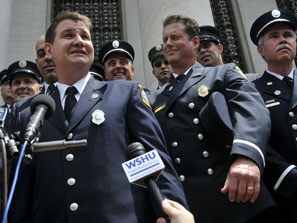
As reported in La Plaza yesterday, the Supreme Court on Monday reversed the ruling made by Judge Sonia Sotomayor and others in the case Ricci v. DeStefano. In awarding the victory to the group of white firefighters from New Haven many believe that the Supreme Court’s decision may have delivered a blow to Judge Sotomayor’s chances for a seat on the Supreme Court.
Justice Anthony Kennedy, writing for the majority side of the 5-4 vote, explained: “Whatever the city’s ultimate aim – however well intentioned or benevolent it might have seemed – the city made its employment decision because of race. The city rejected the test results solely because the higher-scoring candidates were white.” Justice Kennedy was writing on behalf of Chief Justice John Roberts and Justices Antonin Scalia, Clarence Thomas and Samuel Alito.
Even the four dissenting justices used different reasoning than that applied by Sotomayor and the lower court. “While the justices divided on the outcome, all nine justices were critical of the trial court opinion that Judge Sotomayor endorsed,” Sen. John Cornyn (R-Texas) said.
But Senator Chuck Schumer (D-NY) told reporters that this case would have no impact on Sotomayor’s confirmation hearings, explaining, “While the Supreme Court disagreed with the 2nd circuit, they in no way undercut Justice Sotomayor’s contention that she was following legal precedent and was bound to do so.”
Justice Ruth Bader Ginsburg wrote for the dissenting Justices, including Justices John Paul Stevens, David Souter and Stephan Breyer. She explained that Monday’s ruling means that New Haven, a city with a minority population of almost 60 percent, “must today be served – as it was in the days of undisguised discrimination – by a fire department in which members of racial and ethnic minorities are rarely seen in command positions.”
Justice Ginsburg went further saying that the majority’s opinion “ignores substantial evidence of multiple flaws in the tests New Haven used. The Court similarly fails to acknowledge the better tests used in other cities, which have yielded less racially skewed outcomes.”
It was not explicitly said by Justice Ginsberg or the other dissenters that they would have set Sotomayor’s ruling aside, but in a footnote it was said that: “Ordinarily, a remand for fresh consideration would be in order.” Critics point to this believing it suggests that the justices thought the lower-court ruling was flawed.
The White House would like to defend Sotomayor’s ruling, but this is complicated by the fact that, before her nomination, the Justice Department asked the Supreme Court to set aside the ruling Sotomayor was a part of and return the case to the district court.

This decision is hardly a “blow” to Judge Sotomayor despite the best efforts of the Republican partisans.
1. The US Supreme Court did not issue an unanimous decision–it was closely divided.
2. Justice Bader-Ginsburg who was joined by Justice Souter and the other members of the minority would not have reversed the 2nd Circuit decision and in a stinging rebuke to the Justices in the majority read her opinion in open Court. Among other things, she stated that the majority’s decision would not withstand the test of time. In the polite society of the Supreme Court, this is tantamount to a slap in the collective faces of Justices joining in the majority opionion.
3. This was not “Judge Sotomayor’s decision.” In addition to the U.S. District Court judge, the original three judge panel who heard this case who included Judge Sotomayor as well as seven of the members of the 2nd Circuit en banc agreed were in agreement–the Supreme Court overruled the collective decision of all of these judges in addition to precedent and the plain meaning of Title VII.
4. The activist conservative Justices including Thomas, Alito, Scalia, Kennedy, and Roberts deviated in a dramatic fashion from precedent, violated basic rules of construction, ignored the facts of the case, and arrived at a perverse outcome. This is more a blow to law and order and rule of law than to Judge Sotomayor.
5. When Alito was nominated all of his cases that were considered by the U.S. Supreme Court were reversed.
6. Just prior to Roberts’ confirmation, the Court ruled contrary to his position in one of his cases.
7. Politicos’ reporting was shoddy and inaccurate. They continue the misleading practice of failing to mention one of the plaintiffs was Hispanic. Does not fit with their narrative. Who cares about minor details like the FACTS.